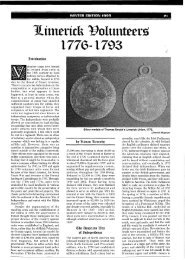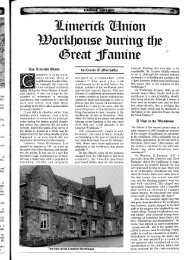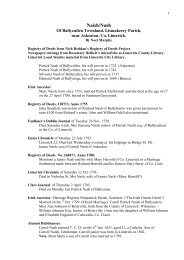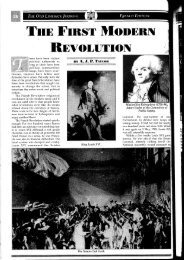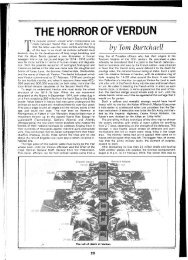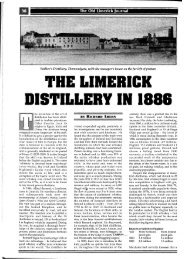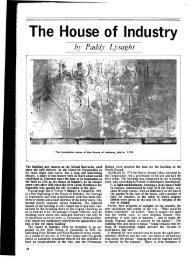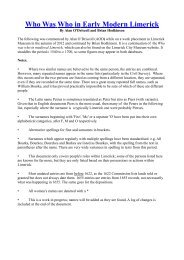pages 555 to 683 (4602 Kb) - Limerick City Council
pages 555 to 683 (4602 Kb) - Limerick City Council
pages 555 to 683 (4602 Kb) - Limerick City Council
Create successful ePaper yourself
Turn your PDF publications into a flip-book with our unique Google optimized e-Paper software.
644 HISTORY OF LIMERICX. . .<br />
ances<strong>to</strong>r, Edmond Sex<strong>to</strong>n, they were granted. White's MSS. assert that,<br />
from the ruins of the monastery of the Canons Regular, the Irish fired<br />
upon the soldiers of King William, as they approached the city from the<br />
heights of Park.<br />
In 1691, we find there were a communit and convent in <strong>Limerick</strong>,<br />
De Burgc alludes <strong>to</strong> a lawsuit between the rior of the convent of St.<br />
Augustine, in <strong>Limerick</strong>, and one William Lysaght, as <strong>to</strong> the possession of<br />
their convent. In that year, the Prior was the celebrated Bernard<br />
O'Kennedy, subsequently Provincid of the Order in Ireland. He afterwards<br />
fled <strong>to</strong> Spain from the horrors of the persecution of William III.,<br />
where he died in 1704. In a aetter which he wrote a little before his<br />
death <strong>to</strong> the province of Ireland, for he was then the Provincial, he<br />
states that he left in trust with a friend in Ireland, a chalice and suit of<br />
vestments for the convent of <strong>Limerick</strong>, which is a proof that a convent had<br />
been there before his departure from Ireland. We find that almost all the<br />
regular clergy, notwithstanding the numbers banished in 1698, continued<br />
in their native land. It was not, however, until the end of the reign<br />
of George I., that regular clergy began <strong>to</strong> live in community and <strong>to</strong> erect<br />
chapels in the princ~pal <strong>to</strong>wns in Ireland. In the next reign, as before<br />
mentioned, and for the last century, we find the Augustinians living in community<br />
in <strong>Limerick</strong>.<br />
In 1736 the Dominicans and Franciscans of <strong>Limerick</strong> applied <strong>to</strong> Dr.<br />
O'KeefTe, the bishop, for redress against the Hermits of St. Augustine,<br />
who, as they alleged, had settled themselves in the city without having<br />
any title for so doing, asserting they never had a convent of their order in<br />
the city. The bishop, attended by his secular clergy, often examined<br />
both parties on the merits of this affair, and ultimately passed sentence<br />
against the Augustinians. The Augustinians appealed <strong>to</strong> Cashel, and<br />
from thence <strong>to</strong> the Primate of Armagh. The Dominicans and Franciscans<br />
would not acknowledge the Primate's jurisdiction in <strong>Limerick</strong>, and therefore<br />
they appealed <strong>to</strong> the Sacred Congregation de Propaganda; but nob<br />
withstanding their appeal, the Primate's commissary in absence of the contending<br />
parties, pronounced a sentence of absolution in favour of the<br />
Augustinians, who, by virtue thereof, opened their chapel, and ever since<br />
continued <strong>to</strong> officiate in the city. In some time after, the Augustinians produced<br />
a decree of the Holy Congregation, declaring their censures suspended<br />
usque ad emiturn causae; they required this decree in their favour<br />
<strong>to</strong> be published in all the chapels, which Dr. John Lehy, the Vicar-<br />
General, refused doing, as the Congregation did not send the decree <strong>to</strong><br />
him. However, the Augustinians still continued <strong>to</strong> have their chapel open<br />
and officiated in <strong>to</strong>wn equally with the rest of the friars in 1755.'<br />
In 1778 the Hermits of St. Augustine erected a neat chapel and chapelhouse<br />
in Creagh Lane, which they occupied until 1893. Their community<br />
were never less than three, and were sometimes four. Their chapel<br />
was the first in the city in which an organ wag erected.<br />
The removal of the community from Creagh Lane <strong>to</strong> George's Street,<br />
which occurred in 1823, was occasioned by the pressing demands for increased<br />
accommodation, and by an opportunity which now occurred of<br />
purchasing the new theatre, which had been recently built, in consequence<br />
White's MSS. The MSS. particulars of the controversy are extant. Fitzgerald statea that<br />
the question in dispute waa "set at rest for ever in 1739 or 1740, by the Canons Regular of<br />
St. Angagtine ceding <strong>to</strong> the said Hermits all their rights, privileges, and immaeitiea".<br />
HISTORY OB LIMERICK. 645<br />
of the burning of the old one, and which was now brought <strong>to</strong> the hammer<br />
for the liquidation of arrears of debt. The theatre had been built by subscription<br />
in 1810, at the expense of £4,000, but the Very Rev. Father<br />
Cronin, the prior, aided by public liberality, purchased it for 2400, and<br />
having insured the premises, employed an architect <strong>to</strong> make such alterations<br />
as would fit it for the service of religion. In negociating this purchase<br />
the prior was assisted by the Rev. D. O'Connor, now Bishop of<br />
Saldes, a distinguished member of the order, and in a few weeks, the work<br />
having been complete, the church was opened with great solemnity, and<br />
consecrated by the bishop of the diocese, the Right Rev. Dr. Tuohy, the<br />
sermon being preached by the celebrated Dr. Doyle, Bishop of Kildare<br />
and Leighlin, who was himself an Augustinian, and whose successful appeal<br />
on this occasion considerably assisted <strong>to</strong> liquidate the building debt. The<br />
alterations and improvements cost about £600 in addition <strong>to</strong> the purchase<br />
money. The interior is about ninety feet in length and sixty in breadth.<br />
The gallery is supported by metal columns and is in the form of a horseshoe.<br />
The new and costly altar of marble, etc., is ornamented by the fine<br />
~ainting of the Ascension by the celebrated artist, Timothy Collopy, a<br />
native of the city, of whom we have already written fully (see p. 344).<br />
This excellent church is principally lighted from the roof.<br />
Of the fathers of the convent who have always been held in deserved<br />
respect by the citizens of <strong>Limerick</strong>, it is only necessary <strong>to</strong> mention the<br />
names of the Very Rev. Thos. Walsh, the Very Rev. Augustine Aylmcr,<br />
the Rev. Patrick Green, the Rev. Thos. Connolly, the Very Rev. Father<br />
Stephen Egan, and the truly estimable Father Augustine Cronin, who were<br />
all distinguished for piety, learning, and amiability. Father Walsh, who built<br />
thc old convent about one hundred years ago, was Provincial of his Order,<br />
lived <strong>to</strong> the age of ninety years, and said Mass every day almost <strong>to</strong> his<br />
death. Father Cronin, who was the principal means of removing the<br />
convent from the old <strong>to</strong> the new <strong>to</strong>wn, did great service <strong>to</strong> religion by the<br />
establishment of confraternities. He died regretted by all who knew him<br />
in 1835.l<br />
The following is an accurate list of the priors from 1760 <strong>to</strong> 1865 :<br />
1760-Very Rev. Thomas Walsh.<br />
1770 ,, ,, James Byrne.<br />
1778 ,, ,, Thomas Walsh.<br />
1786 ,, ,, Augustine Aylmer.<br />
1811 ,, ,, Stephen Egan.<br />
1815 ,, ,, John Augustine Cronin.<br />
1819 ,, ,, Stephen Egan.<br />
1823 ,, ,, John Augustine Cronin.<br />
1835 ,, ,, Robert Dore.<br />
1839 ,, ,, James Dundon.<br />
1843 , ,, Robert Dore.<br />
1855 ,, ,, James Dundon.<br />
1859 ,, ,, Robert Dore.<br />
1863 ,, ,, James Dundon, the present prior, 1865.<br />
The Very Rev. Fathers Epn and Cronin are interred in the old vault on the n~rth<br />
side of<br />
St. Patrick's churchyard. The former died on the 26th of June, 1832, sged 76 years; the<br />
latter on the 23rd February, 1835, aged 64 years.



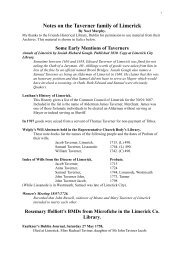

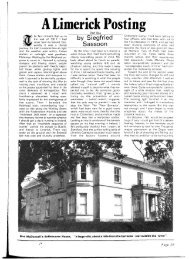
![The Galbally farmer [poem] by Darby Ryan - Limerick City Council](https://img.yumpu.com/24792577/1/190x260/the-galbally-farmer-poem-by-darby-ryan-limerick-city-council.jpg?quality=85)
